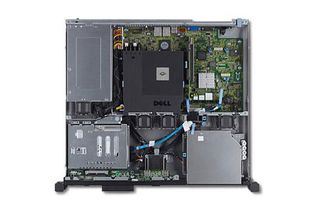IT Pro Verdict
Dell’s PowerEdge R210 II is a worthy choice as an entry level rack server for small businesses or a low cost compute node for data centres short on space. The price for the review system is quite high, but this does include the fastest Xeon E3 processor currently available and by picking a slower Xeon E3 you can drop the price substantially. Storage options and remote management features are very good and it rectifies the high operational noise levels of its predecessor.

The Dell PowerEdge R210 II

The Dell PowerEdge R210 II with its top off.

The interior of the Dell PowerEdge R210 II as seen from above.

For web-based remote management you’ll need Dell’s iDRAC6 Express or Enterprise modules.

The iDRAC6 provides full access to server power so you can remotely turn it on and off and reset it.

The review system came with the iDRAC6 Enterprise module which includes KVM-over-IP remote control and virtual media services

The iDRAC6 modules enable Dell’s Lifecycle Controller and UEFI which provide some handy operating system deployment tools.
Despite being launched by Intel some months ago it's taken a while for servers fitted with its new Xeon E3 processor to actually come to market and Dell is the first. Its latest PowerEdge R210 II is designed for a range of environments from SMBs to enterprises and remote offices, but one thing they'll all appreciate is its compact dimensions.


The server is available with a good choice of processors, starting with a low-cost 3.1GHz Core i3. The server has seven Xeon E3 options starting with a 3.1GHz E3-1220. The system on review was specced out for performance and came with the top of the range 3.5GHz Xeon E3-1280. You'll pay for the privilege though, as this processor costs a hefty 390 extra. SMBs will be better off considering the 3.3GHz E3-1240 as this'll shave at least 260 off the price.
The server is very solidly built with most of the front panel acting as a grill to improve air flow. Dell's four-pack LED diagnostics panel is fitted as standard, but the LCD control panel as used by the higher-end PowerEdge servers is not an option.
Despite its compact dimensions, internal design is nice and tidy with easy access to all key components. A new feature we were very pleased to see (and hear) is the acoustic improvements. The original R210 had problems cooling its Xeon 3400 processor and the end result was excessive noise levels from the cooling fan making it unsuitable for small offices. The R210 II has four small fans cooling the power supply, processor and expansion bay, but they run much slower and are therefore a lot quieter.
Dave is an IT consultant and freelance journalist specialising in hands-on reviews of computer networking products covering all market sectors from small businesses to enterprises. Founder of Binary Testing Ltd – the UK’s premier independent network testing laboratory - Dave has over 45 years of experience in the IT industry.
Dave has produced many thousands of in-depth business networking product reviews from his lab which have been reproduced globally. Writing for ITPro and its sister title, PC Pro, he covers all areas of business IT infrastructure, including servers, storage, network security, data protection, cloud, infrastructure and services.
